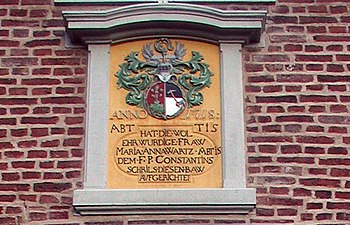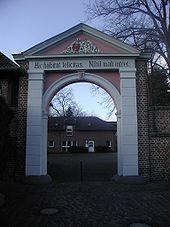Benden Monastery
Kloster Benden was a Cistercian - Abbey in what is now the district of Heath of Brühl in the Rhineland . The remaining parts of the complex have been restored and are now used for residential purposes.
location
Benden Monastery is located on the upper eastern slope of the Ville , the promontory , in the Benden , the meadows of the little valley of the Mühlenbach, formerly known as the Siegesbach. Characteristic features for the choice of location when a new Cistercian monastery is founded can also be seen for this location. The nuns found seclusion here, fertile loess soil for cultivation and clear water. This meant that later even the grain and oilseeds produced could be processed in our own mills.
The monastery and the Heide district to the west can be reached via the B 265 (Luxemburger Straße) or from the center of Brühl via the L 184 (Theodor-Heuss-Straße), Willy-Brandt-Straße junction.
history
The monastery Benden with its former monastery church is called in old documents of the order Conventus in prato beatae Mariae virginis " Convent on the meadow of the Blessed Virgin Mary "; therefore the monastery consecrated to the Virgin Mary was also called Marien-Benden. The location is added to this designation in further documents.
Foundation and early Middle Ages
The Benden monastery is first mentioned in a document from Margareta von Hersel (Herzelle, Heerseel). In 1207 she founds the Cistercian convent.
A document from 1231 also mentions Benden monastery in connection with Knight Hermann, son of Lambert von Merreche. The same document also uses the name Marienbenden bei Merrege . Konrad von Hochstaden , Archbishop of Cologne , granted the venerable Marienbenden nunnery ( conventum Sanctimonialium beatae Mariae in prato prope Meregge ) the privilege of immunity for its goods in June 1238 . Merreche or Merrege later becomes "Kirchberg", today's neighboring town of Kierberg .
Benden monastery with its church burned down several times in its eight hundred year history, the first time in 1388, and was then restored by a Cologne canonicus and official .
In 1503, during the term of office of the abbess Dorothea Ruttenbach, the Cistercian abbey burned down again and was abandoned for 30 years. Later, the abbess Christina Ruttenbach, who took office, began to rebuild, but it was not until 1589 that the abbess Christina Gebels was able to complete the new building.
The abbot von Altenberg was responsible for the spiritual direction and supervision of the monastery .
Ending Middle Ages and Modern Times
In the vicinity of the monastery, on the Villehöhe, which is probably called “Heide”, a small hamlet of secular workers who are dependent on the monastery is developing. In a list from 1669 (Kölnische Landesdescription) the following properties are listed for the Benden monastery: Gütchen Bendel with 25 acres, 290 acres managed by the monastery itself, the Bender mill, the Theism mill in Kierberg and the lignite mine near the monastery. According to a register by the Kierberg pastor Mauel, in 1747 Kierberg and Heide had together 36 houses with 37 families. A house is given for the monastery itself.
secularization
After the Napoleonic wars , the buildings, lands and property of the monasteries and dioceses were secularized and passed into state ownership. Marienbenden Monastery was also affected by the abolition of religious institutions and the takeover of church property.
Around 1803, the Cologne broker Everhard Henner bought the monastery, along with the church and building, and had all the buildings demolished with the exception of the abbess's house, which he expanded into his country residence in 1806, and the farmyard. His heirs sold it to Friedrich Giesler the Elder in 1844. Ä. His son of the same name had the tower with the baroque dome and probably also the gate built in 1889.
In 1802 the monastery church consecrated to St. Bernhard was demolished, parts of the interior were taken to the parish church of St. Margareten in Brühl and from there after the construction of a church in Kierdorf in 1904. In the parish church of St. Martin in Fischenich , there is also an inventory of the former monastery church: parts of the stalls and the baroque organ . A tower was added in 1883 by the next owner of the monastery building, named a Mr. Giesler from Falkenlust .
The coat of arms above the main entrance, which is still preserved today, has the inscription : “In 1718 the worthy Fraw Maria Anna Warts Abtis (with) FP Constantin Schrils erected this building. “It is the last reminder of the women's monastery.
Today's facility
The brick building of the baroque building that exists today comes from a new building from the 18th century with remains from the 16th century. Inside, the original, partly painted stucco ceilings from 1719 have been preserved. The monastery courtyard, which had come to Rheinbraun in 1907 via the Gruhlwerk briquette factory , was used for agriculture until 1988 . Since then, the main building - renovated - has served as the representative seat of a law firm. The old surrounding farm buildings were demolished in 1988 by a Cologne contractor or converted into condominiums. A courtyard was designed with the new buildings. Today 20 families live on the farm. Behind the former monastery, the nuns' ornamental garden, which has been converted into a lawn, extends to the adjacent Bergstrasse. There are still some restored servants' houses integrated into the massive monastery wall . The original monastery wall, which stretched a few hundred meters uphill, surrounded the kitchen garden of the monastery that adjoined the ornamental garden. This area was also sold and built with single-family houses in gardens.
Benden Monastery in literature
The novel by the Argentine author Carlos Rodrigues Gesualdi , who lives in Brühl , is set in the Benden monastery : Una gata con todos los nombres del mundo ( A cat with all the names in the world ), which won the Libresa Prize for children's literature in Ecuador . Several illustrations in the book show today's houses.
literature
- Robert Wilhelm Rosellen: History of the parishes of the deanery Brühl. JP Bachem Verlag, Cologne 1887.
- Carlos Rodrigues Gesualdi: Una gata con todos los nombres del mundo. Libresa, Quito, 2009.
Web links
Coordinates: 50 ° 50 ′ 6 ″ N , 6 ° 52 ′ 30 ″ E



